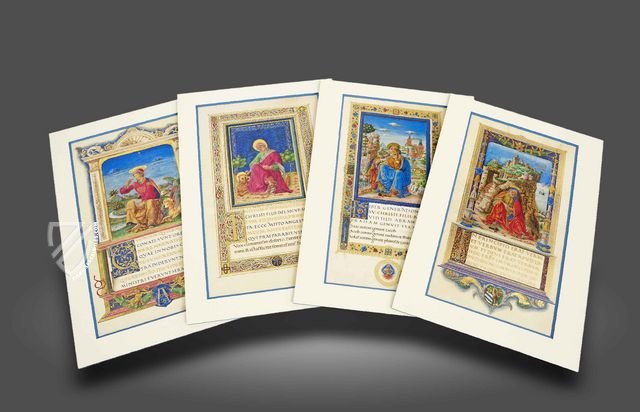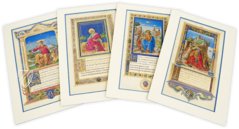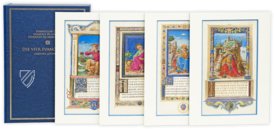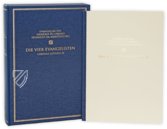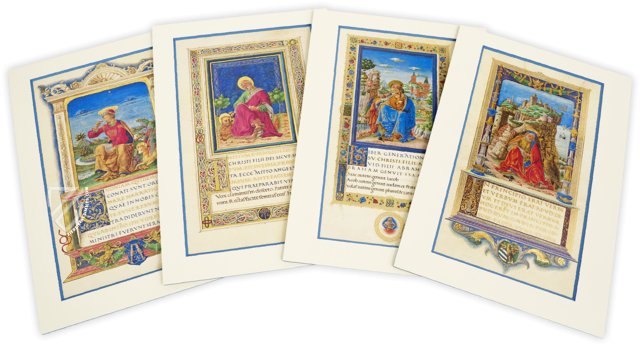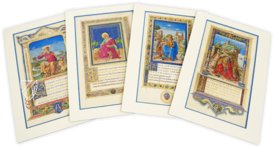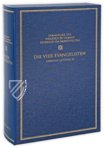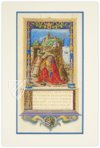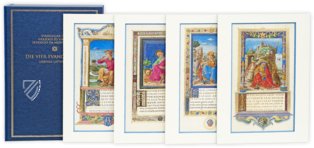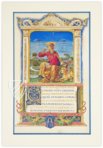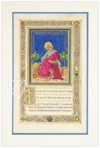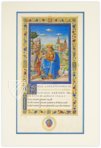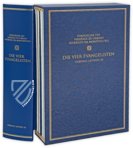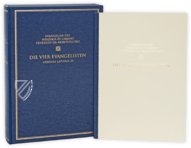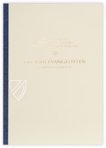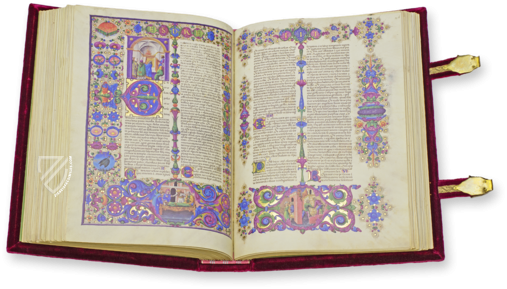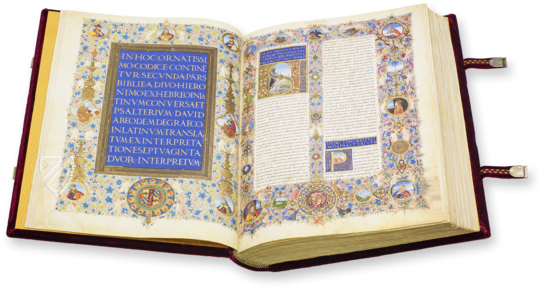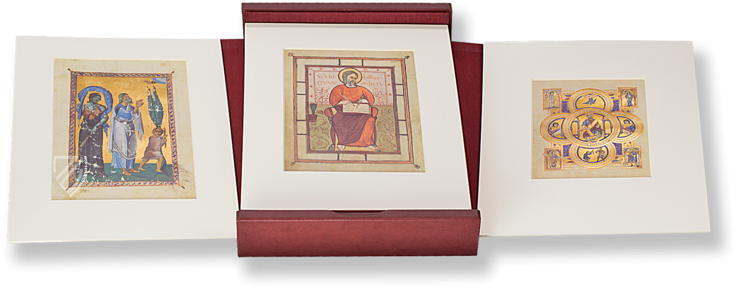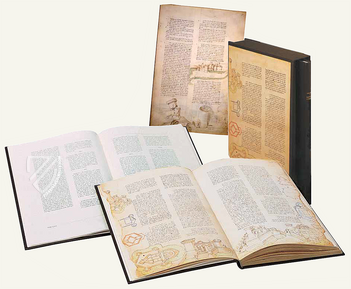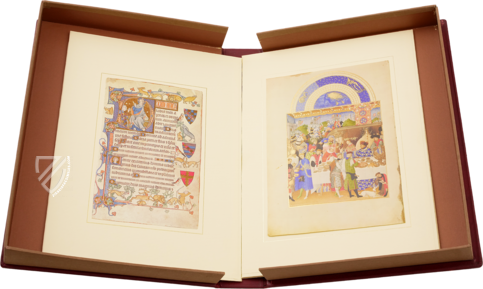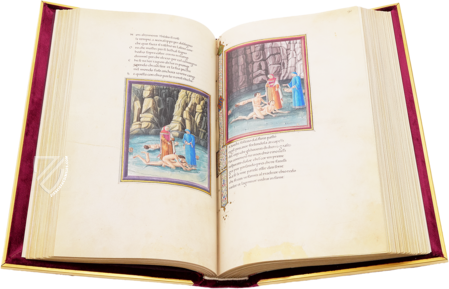The Four Evangelists
(under 1,000€)
This single-page collection presents four of the most stunning Evangelist portraits probably ever created. They derive from the splendid Gospels of the Duke of Urbino, Federico da Montefeltro (1422–82), which is preserved in the Vatican Library under the shelfmark Urbinas Latinus 10. The precious manuscript was produced around 1474 either in Ferrara or Urbino by order of the famous condottiere, who was known for his spectacular rise and military skill, but also as a great patron of the arts and a just lord who ruled according to humanistic principles. The four large-scale and gold-decorated Evangelist images of his Gospel Book represent a highlight of his rich art collection, and are notable for their realistic depiction of the body and their breathtaking coloring. The four Evangelists are set in wide, fantastical landscapes against brilliant blue skies, while the pages are enclosed by beautiful decorated framings.
The Four Evangelists
The Book of Gospels that once belonged to the Duke of Urbino is a masterfully executed but practical religious text with décor limited to canon tables, the opening page of the prologue of St. Jerome featuring an elaborate frame and a historiated initial of the famous ascetic and Church Father, numerous smaller colored initials, and four incipit pages across from which these masterful Evangelist portraits appear. Artistically, these are the “meat” of the manuscript and are outstanding specimens of this ancient tradition of Christian art that exhibit the technical innovations of the Italian Renaissance. These four Evangelist portraits are richly colored and highlighted with gold, presented in artful frames, and depict the authors of the Gospels with natural body postures, facial expressions, and garment fall of folds. Some feature elaborate landscapes in the background while all are presented with their Evangelist symbols, artful initials and opening lines of text written so neatly they appear printed.
Evolution of the Evangelist Portrait
Evangelist portraits are among the oldest images in Christian art and originated from the classical tradition of author portraits and the conventions of consular portraits from Late Antiquity. Evangelist portraits modelled on the latter show the author holding their Gospel but not writing it, front-facing, enthroned, and surrounded by an elaborate, often architectural frame. The Insular tradition of illumination introduced the variation of showing them seated at an oblique angle and engaged in writing their respective Gospels as well as pairing the Evangelists with their symbols: the Lion of Mark, the Eagle of John, the Ox or Calf of Luke and the Angel or Man of Matthew. In some cases, these symbols were depicted as though they were giving dictation.
The Light of Italy
Federico da Montefeltro (1422–82) was a shining example of what it meant to be a Renaissance prince: a successful military leader, generous patron of the arts, and liberal ruler who was guided by humanist principles in administering justice to his people. He patronized important authors like Cristoforo Landino (1424–98) and supported the development of talented artists including a young Raphael (1483–1520). Furthermore, Federico had a private scriptorium where he employed the most talented copyists who produced the most comprehensive library outside of the Vatican. All of this was not merely for show and Federico commissioned a studiolo – a small study or cabinet for contemplation – to be built in his palaces at Urbino and Gubbio. Both survive today: the former is still in Urbino while the latter was purchased by the Metropolitan Museum of Art, shipped to New York City, and reassembled piece-by-piece. For all this and more, Federico is has been nicknamed “the Light of Italy”.
Codicology
- Alternative Titles
- Gospels of the Duke of Urbino: Federigo da Montefeltro
- Size / Format
- 4 single leaves / 26.0 × 40.5 cm
- Origin
- Italy
- Date
- Around 1474
- Epochs
- Style
- Genre
- Language
- Illustrations
- 4 full-page miniatures
- Content
- Four portraits of evangelists from the Gospels of Federico da Montefeltro
- Patron
- Federico da Montefeltro, Duke of Urbino (1448–82)
The Four Evangelists
Matthew the Evangelist
Wrapped in a blue robe, Matthew is shown rubbing his chin in contemplation with one hand and holding a quill in the other as he writes his Gospel. Meanwhile, his symbol, an angel, holds up a hand with his index finger extended as though he were about to make a suggestion. Both figures are adorned with shimmering gold halos that are not flat but appear tilted and three-dimensional instead. An inkwell and a container holding more quills and a knife is depicted at the saint’s feet.
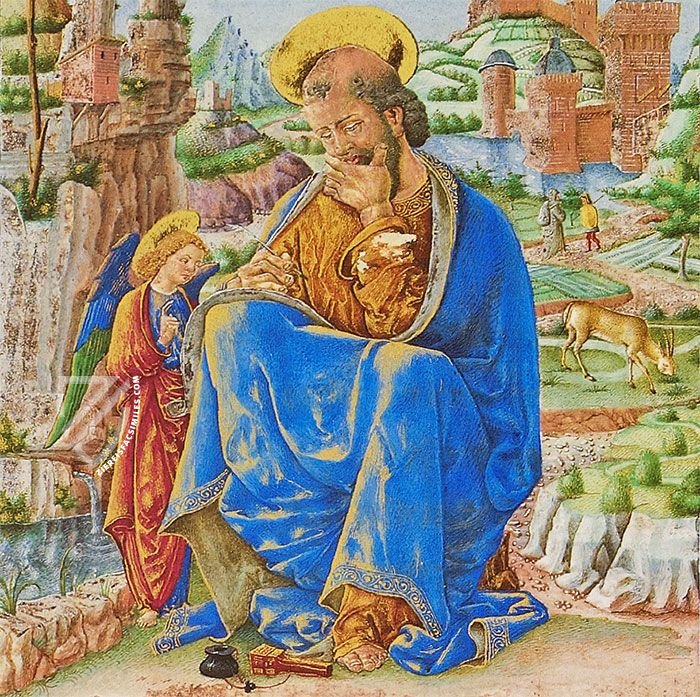
The Four Evangelists
John the Evangelist
According to tradition, John the Evangelist spent the last years of his life in exile on the island of Patmos, where he wrote the Book of Revelation. Although most modern scholars believe it was written by a different John, he is nonetheless depicted writing on an island, above which appears seven lampstands representing the seven churches of Asia.
John sits next his eagle, which is also the symbol of Urbino in combination with a blue and gold striped shield, both of which appear at the bottom of the page. Above them, a splendid “I” initial wrapped with golden tendrils introducing the incipit, which is written in gold ink. The letters FE and DUX appear on either side of the laurels hanging overhead, a reference to Duke Federico da Montefeltro.
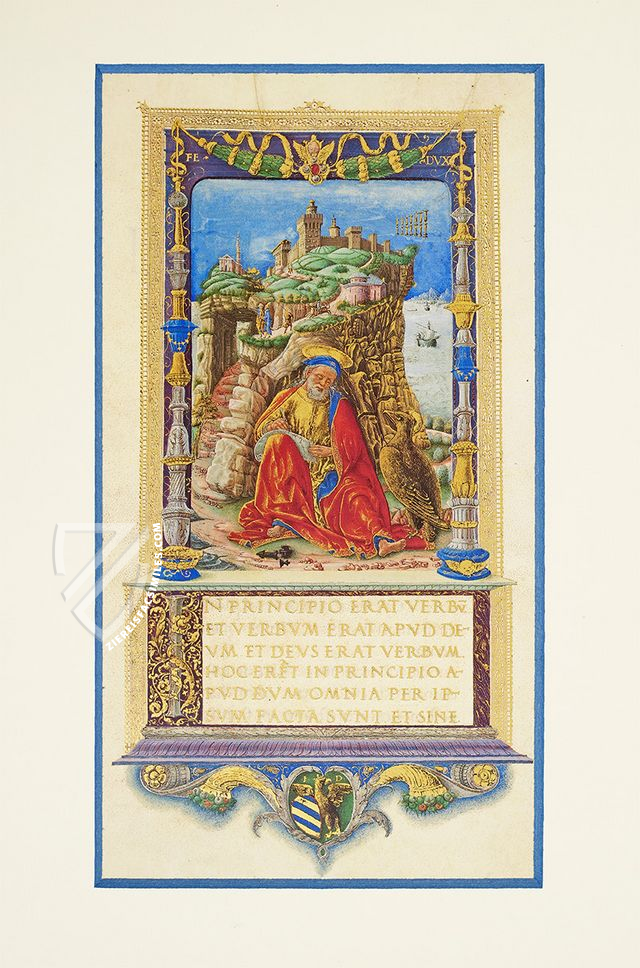
#1 Die vier Evangelisten - Urbinas Latinus 10
Language: German
(under 1,000€)
- Treatises / Secular Books
- Apocalypses / Beatus
- Astronomy / Astrology
- Bestiaries
- Bibles / Gospels
- Chronicles / History / Law
- Geography / Maps
- Saints' Lives
- Islam / Oriental
- Judaism / Hebrew
- Single Leaf Collections
- Leonardo da Vinci
- Literature / Poetry
- Liturgical Manuscripts
- Medicine / Botany / Alchemy
- Music
- Mythology / Prophecies
- Psalters
- Other Religious Books
- Games / Hunting
- Private Devotion Books
- Other Genres
- Afghanistan
- Armenia
- Austria
- Belgium
- Belize
- Bosnia and Herzegovina
- China
- Colombia
- Costa Rica
- Croatia
- Cyprus
- Czech Republic
- Denmark
- Egypt
- El Salvador
- Ethiopia
- France
- Germany
- Greece
- Guatemala
- Honduras
- Hungary
- India
- Iran
- Iraq
- Israel
- Italy
- Japan
- Jordan
- Kazakhstan
- Kyrgyzstan
- Lebanon
- Liechtenstein
- Luxembourg
- Mexico
- Morocco
- Netherlands
- Palestine
- Panama
- Peru
- Poland
- Portugal
- Romania
- Russia
- Serbia
- Spain
- Sri Lanka
- Sweden
- Switzerland
- Syria
- Tajikistan
- Turkey
- Turkmenistan
- Ukraine
- United Kingdom
- United States
- Uzbekistan
- Vatican City
- A. Oosthoek, van Holkema & Warendorf
- Aboca Museum
- Ajuntament de Valencia
- Akademie Verlag
- Akademische Druck- u. Verlagsanstalt (ADEVA)
- Aldo Ausilio Editore - Bottega d’Erasmo
- Alecto Historical Editions
- Alkuin Verlag
- Almqvist & Wiksell
- Amilcare Pizzi
- Andreas & Andreas Verlagsbuchhandlung
- Archa 90
- Archiv Verlag
- Archivi Edizioni
- Arnold Verlag
- ARS
- Ars Magna
- ArtCodex
- AyN Ediciones
- Azimuth Editions
- Badenia Verlag
- Bärenreiter-Verlag
- Belser Verlag
- Belser Verlag / WK Wertkontor
- Benziger Verlag
- Bernardinum Wydawnictwo
- BiblioGemma
- Biblioteca Apostolica Vaticana (Vaticanstadt, Vaticanstadt)
- Bibliotheca Palatina Faksimile Verlag
- Bibliotheca Rara
- Boydell & Brewer
- Bramante Edizioni
- Bredius Genootschap
- Brepols Publishers
- British Library
- C. Weckesser
- Caixa Catalunya
- Canesi
- CAPSA, Ars Scriptoria
- Caratzas Brothers, Publishers
- Carus Verlag
- Casamassima Libri
- Centrum Cartographie Verlag GmbH
- Chavane Verlag
- Christian Brandstätter Verlag
- Circulo Cientifico
- Club Bibliófilo Versol
- Club du Livre
- CM Editores
- Collegium Graphicum
- Collezione Apocrifa Da Vinci
- Comissão Nacional para as Comemorações dos Descobrimentos Portugueses
- Coron Verlag
- Corvina
- CTHS
- D. S. Brewer
- Damon
- De Agostini/UTET
- De Nederlandsche Boekhandel
- De Schutter
- Deuschle & Stemmle
- Deutscher Verlag für Kunstwissenschaft
- DIAMM
- Droz
- E. Schreiber Graphische Kunstanstalten
- Ediciones Boreal
- Ediciones Grial
- Ediclube
- Edições Inapa
- Edilan
- Editalia
- Edition Deuschle
- Edition Georg Popp
- Edition Leipzig
- Edition Libri Illustri
- Editiones Reales Sitios S. L.
- Éditions de l'Oiseau Lyre
- Editions Medicina Rara
- Editorial Casariego
- Editorial Mintzoa
- Editrice Antenore
- Editrice Velar
- Edizioni Edison
- Egeria, S.L.
- Eikon Editores
- Electa
- Emery Walker Limited
- Enciclopèdia Catalana
- Eos-Verlag
- Ephesus Publishing
- Ernst Battenberg
- Eugrammia Press
- Extraordinary Editions
- Fackelverlag
- Facsimila Art & Edition
- Facsimile Editions Ltd.
- Facsimilia Art & Edition Ebert KG
- Faksimile Verlag
- Feuermann Verlag
- Folger Shakespeare Library
- Franco Cosimo Panini Editore
- Friedrich Wittig Verlag
- Fundación Hullera Vasco-Leonesa
- G. Braziller
- Gabriele Mazzotta Editore
- Gebr. Mann Verlag
- Gesellschaft für graphische Industrie
- Getty Research Institute
- Giovanni Domenico de Rossi
- Giunti Editore
- Graffiti
- Grafica European Center of Fine Arts
- Guido Pressler
- Guillermo Blazquez
- Gustav Kiepenheuer
- H. N. Abrams
- Harrassowitz
- Harvard University Press
- Helikon
- Hendrickson Publishers
- Henning Oppermann
- Herder Verlag
- Hes & De Graaf Publishers
- Hoepli
- Holbein-Verlag
- Houghton Library
- Hugo Schmidt Verlag
- Idion Verlag
- Il Bulino, edizioni d'arte
- ILte
- Imago
- Insel Verlag
- Insel-Verlag Anton Kippenberger
- Instituto de Estudios Altoaragoneses
- Instituto Nacional de Antropología e Historia
- Introligatornia Budnik Jerzy
- Istituto dell'Enciclopedia Italiana - Treccani
- Istituto Ellenico di Studi Bizantini e Postbizantini
- Istituto Geografico De Agostini
- Istituto Poligrafico e Zecca dello Stato
- Italarte Art Establishments
- Jan Thorbecke Verlag
- Johnson Reprint Corporation
- Josef Stocker
- Josef Stocker-Schmid
- Jugoslavija
- Karl W. Hiersemann
- Kasper Straube
- Kaydeda Ediciones
- Kindler Verlag / Coron Verlag
- Kodansha International Ltd.
- Konrad Kölbl Verlag
- Kurt Wolff Verlag
- La Liberia dello Stato
- La Linea Editrice
- La Meta Editore
- Lambert Schneider
- Landeskreditbank Baden-Württemberg
- Leo S. Olschki
- Les Incunables
- Liber Artis
- Library of Congress
- Libreria Musicale Italiana
- Lichtdruck
- Lito Immagine Editore
- Lumen Artis
- Lund Humphries
- M. Moleiro Editor
- Maison des Sciences de l'homme et de la société de Poitiers
- Manuscriptum
- Martinus Nijhoff
- Maruzen-Yushodo Co. Ltd.
- MASA
- Massada Publishers
- McGraw-Hill
- Metropolitan Museum of Art
- Militos
- Millennium Liber
- Müller & Schindler
- Nahar - Stavit
- Nahar and Steimatzky
- National Library of Wales
- Neri Pozza
- Nova Charta
- Oceanum Verlag
- Odeon
- Orbis Mediaevalis
- Orbis Pictus
- Österreichische Staatsdruckerei
- Oxford University Press
- Pageant Books
- Parzellers Buchverlag
- Patrimonio Ediciones
- Pattloch Verlag
- PIAF
- Pieper Verlag
- Plon-Nourrit et cie
- Poligrafiche Bolis
- Presses Universitaires de Strasbourg
- Prestel Verlag
- Princeton University Press
- Prisma Verlag
- Priuli & Verlucca, editori
- Pro Sport Verlag
- Propyläen Verlag
- Pytheas Books
- Quaternio Verlag Luzern
- Reales Sitios
- Recht-Verlag
- Reichert Verlag
- Reichsdruckerei
- Reprint Verlag
- Riehn & Reusch
- Roberto Vattori Editore
- Rosenkilde and Bagger
- Roxburghe Club
- Salerno Editrice
- Saltellus Press
- Sandoz
- Sarajevo Svjetlost
- Schöck ArtPrint Kft.
- Schulsinger Brothers
- Scolar Press
- Scrinium
- Scripta Maneant
- Scriptorium
- Shazar
- Siloé, arte y bibliofilia
- SISMEL - Edizioni del Galluzzo
- Sociedad Mexicana de Antropología
- Société des Bibliophiles & Iconophiles de Belgique
- Soncin Publishing
- Sorli Ediciones
- Stainer and Bell
- Studer
- Styria Verlag
- Sumptibus Pragopress
- Szegedi Tudomànyegyetem
- Taberna Libraria
- Tarshish Books
- Taschen
- Tempus Libri
- Testimonio Compañía Editorial
- Thames and Hudson
- The Clear Vue Publishing Partnership Limited
- The Facsimile Codex
- The Folio Society
- The Marquess of Normanby
- The Richard III and Yorkist History Trust
- Tip.Le.Co
- TouchArt
- TREC Publishing House
- TRI Publishing Co.
- Trident Editore
- Tuliba Collection
- Typis Regiae Officinae Polygraphicae
- Union Verlag Berlin
- Universidad de Granada
- University of California Press
- University of Chicago Press
- Urs Graf
- Vallecchi
- Van Wijnen
- VCH, Acta Humaniora
- VDI Verlag
- VEB Deutscher Verlag für Musik
- Verlag Anton Pustet / Andreas Verlag
- Verlag Bibliophile Drucke Josef Stocker
- Verlag der Münchner Drucke
- Verlag für Regionalgeschichte
- Verlag Styria
- Vicent Garcia Editores
- W. Turnowski Ltd.
- W. Turnowsky
- Waanders Printers
- Wiener Mechitharisten-Congregation (Wien, Österreich)
- Wissenschaftliche Buchgesellschaft
- Wissenschaftliche Verlagsgesellschaft
- Wydawnictwo Dolnoslaskie
- Xuntanza Editorial
- Zakład Narodowy
- Zollikofer AG

